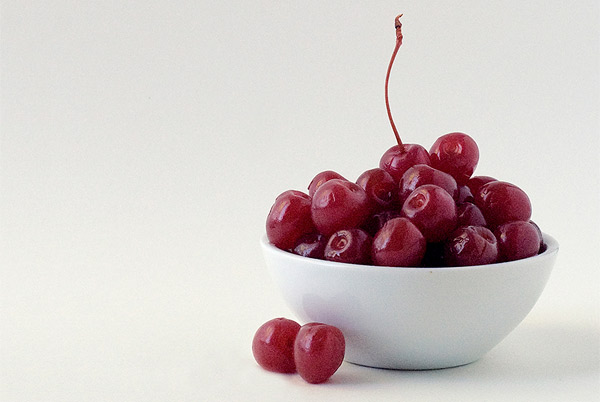
The Maraschino Cherry Goes Natural
For many of us, the iconic maraschino cherry has been a part of our lives from our first kiddie mocktail, the Shirley Temple, to the grown up cocktail, the Manhattan. The bright red cherries have topped cupcakes, adorned ice cream sundaes, and been eaten straight from the jar for longer than you may have imagined.
If your love affair with the maraschino cherry ended due to the common use of high fructose corn syrup and artificial red dye in processing, you will be happy to learn that a revolution is taking place: the maraschino cherry has gone natural!
In response to growing consumer demand for a healthier, more natural product, processors are now making maraschino cherries that are all natural, free of high fructose corn syrup, artificial dyes and flavors, and preservatives.
This new devolvement is only the latest in the long history of maraschino cherries, which dates back several centuries. The original maraschino cherry bears little resemblance to the sweet, bright red maraschino of today. The ancestor of today’s maraschino was the marasca, a small, sour, black cherry that grew wild on the coast of present-day Croatia. In order to preserve the cherries, the locals would first brine them in sea water and then marinate them in a liqueur called maraschino, which was developed in Italy where it received its name. The maraschino liqueur was a spirit made from the marasca’s juice, pits, and leaves and had a slightly bitter almond flavor.
Wealthy Europeans developed a taste for the liqueur-soaked cherries and before long variations of the original formula started popping up throughout Europe. According to John Mariani in The Dictionary of American Food and Drink, the French “flavored and colored their own local cherries bright red and called them maraschinos.”
Eventually the maraschino made its way to America in the 1890’s as a delicacy served in the country’s finest restaurants and hotels. Popularity for the European import grew and soon American manufacturers started to produce their own versions. Early American maraschinos were produced on the East Coast from brined cherries imported from Italy. By the end of the 1800’s, US manufacturers began experiments using a sweet domestic cherry called the Royal Anne grown in Oregon.
At first, the Royal Anne cherries proved problematic for maraschino manufacturer hopefuls. The fruit spoiled quickly and took on a mushy consistency when preserved. This was not the maraschino that wealthy Americans were clamoring for, so experiments continued. Less liqueur was used in processing and almond oil was added.
In the 1920’s, as the prohibition era took hold in America, the ban on alcohol demanded a solution for the liqueur-soaked cherries if Americans were still going to enjoy the maraschinos they had come to crave. For six years in the 1920’s and 30’s, Oregon State University Professor Ernest H. Wiegand (father of the modern day maraschino) worked to develop a new preservation process for the Royal Anne cherries, which included adding calcium salts to the brine in which the cherries were soaked. This was a break-through that revolutionized the maraschino industry. His process also allowed for the cherries to be produced alcohol-free.
At roughly the same time, a tariff was imposed by the American government, making the imported Italian cherries used by east coast manufacturers extremely expensive. As a result of both Wiegand’s processing breakthrough and the government imposed tariff, Oregon became the center of maraschino cherry manufacturing.
Until recently, the processing of maraschinos has remained relatively unchanged. Cherries are soaked in brine to remove their natural color and flavoring. They are then pitted and soaked in sweetener for around a month. The final step is dipping the cherry in artificial coloring, which produces the iconic bright red color.
Responding to demand from health conscious consumers, two of the largest maraschino processors, Gray & Company and Oregon Cherry Growers, have been working for the past several years to develop a natural maraschino. After much trial and error, both companies have successfully developed maraschinos which are free of artificial ingredients and preservatives, high fructose corn syrup, and red dye.
Maraschinos produced by Gray & Company, a century old company, under the brand name Cherry Man will begin shipping to major American grocers in May 2013 and hope to be available in most US markets by the fall of 2013. Their Farm to Market natural cherries can also be purchased through their website (www.cherryman.com), which provides a way to track the cherries you purchase from farm to table. Each jar has a unique QR code that can be scanned to reveal the exact origin of the fruit and the story behind the growers. According to Josh Reynolds, President of Gray & Company, the taste of the new cherries is “reminiscent of something out of the orchard. We have eliminated the chemical aftertaste of conventional maraschinos.”
Oregon Cherry Growers, the world’s largest producer and processor of sweet cherries and a grower-owned cooperative, has developed four different varieties of natural maraschino cherries under the Royal Harvest brand. The Nature’s
Maraschino with Stems is reminiscent of the traditional maraschino. The Bordeaux is the maraschino for the adult palate made with whole, extra-large Bing cherries, resulting in a sophisticated flavor and rich mahogany color. The Pink Blush variety has a unique (naturally derived) pink color and bright taste. To help raise awareness the pink color was specifically chosen to reflect the work of Susan G. Komen for the Cure in breast cancer awareness, prevention, and medical research. Royal Harvest’s newest variety, the Rainier, has the color and flavor of the coveted Rainier cherry. All varieties are free of corn syrup, sulfites, preservatives, and artificial flavorings and dye. According to Tim Ramsey, CEO of Oregon Cherry Growers, the new natural maraschinos “can be used more as an ingredient in cooking and baking as opposed to the typical use as garnishment like traditional maraschinos.” Their natural cherries are currently available in specialty food stores and on their website (www.oregoncherryonline.com). The organization is in the process of launching the products nationally.
This newest evolution in the long history of maraschino cherries is a reflection of the healthier times and great news for those who have had to forgo the fun and flavor of traditional maraschinos. The neon-bright red has been complimented by a subtler, more natural color, reflecting the true beauty of the centuries-old delicacy.



